Intonation (English): Unterschied zwischen den Versionen
| Zeile 91: | Zeile 91: | ||
<br> | <br> | ||
[[Frédéric Rapin #Mâchoire stable - gorge, voyelle et glotte flexibles|Frédéric Rapin]] attaches great importance to the "availability" of the larynx and glottis, and to voicing – for the purpose of correcting intonation – as well as to the fact that the embouchure and airflow remain as a stable unit. | [[Frédéric Rapin #Mâchoire stable - gorge, voyelle et glotte flexibles|Frédéric Rapin]] attaches great importance to the "availability" of the larynx and glottis, and to voicing – for the purpose of correcting intonation – as well as to the fact that the embouchure and airflow remain as a stable unit. | ||
[[Kategorie:Fundamentals, English]] | |||
==Correcting by Changing the Embouchure Pressure & Adjusting Airflow== | ==Correcting by Changing the Embouchure Pressure & Adjusting Airflow== | ||
[[Gerald Kraxberger#Musculus masseter contra Musculus orbicularis oris|Gerald Kraxberger]] makes sure to create the necessary embouchure pressure with the lip muscles ([[Embouchure#Muscle activations and its Functions|Musculus orbicularis oris) and not with the jaw muscles ([[Embouchure#Embouchure Pressure|Musculus masseter]]). This is best practiced using only the barrel and mouthpiece, since the differences in pitch are very clearly perceptible here. If a downward correction of intonation is necessary, [[Seunghee Lee#Techniques to change the pitch|Seunghee Lee]] and [[Thomas Piercy#Intonation|Thomas Piercy]] lighten the pressure on the reed. At the same time as the embouchure is loosened, the airflow and support must be adjusted and strengthened. | [[Gerald Kraxberger#Musculus masseter contra Musculus orbicularis oris|Gerald Kraxberger]] makes sure to create the necessary embouchure pressure with the lip muscles ([[Embouchure#Muscle activations and its Functions|Musculus orbicularis oris) and not with the jaw muscles ([[Embouchure#Embouchure Pressure|Musculus masseter]]). This is best practiced using only the barrel and mouthpiece, since the differences in pitch are very clearly perceptible here. If a downward correction of intonation is necessary, [[Seunghee Lee#Techniques to change the pitch|Seunghee Lee]] and [[Thomas Piercy#Intonation|Thomas Piercy]] lighten the pressure on the reed. At the same time as the embouchure is loosened, the airflow and support must be adjusted and strengthened. | ||
Version vom 28. April 2021, 21:00 Uhr
Contributions by Interviewees
- Michel Arrignon
- Paolo Beltramini
- François Benda 1, 2
- Alain Billard
- James Campbell
- Alain Damiens
- Eli Eban
- Steve Hartman, 2
- Sylvie Hue
- Gerald Kraxberger
- Seunghee Lee 1, 2
- Ernesto Molinari
- Pascal Moraguès
- Harri Mäki 1, 2, 3
- Heinrich Mätzener 1, 2, 3, 4
- Thomas Piercy 1, 2
- Frédéric Rapin 1, 2
- Milan Rericha
- Ernst Schlader
- David Shifrin
- Richard Stoltzman*
- Jérôme Verhaeghe
Ear Training
For James Campbell ist it is clear: only if one can sing a passage, can one intone it correctly. The ear must be awake at every moment, listening ahead and controlling what is being played.
Thomas Piercy describes his lessons with Gervase de Peyer, who would stop him at any time and have him sing rather than play the following note. This is a hint that for a clean intonation, the larynx and glottis should always feel the pitch.
Jérôme Verhaeghe speaks emphatically of hearing, which must be trained first and foremost. Only with an exact idea of the pitch can a sound be correctly intoned. The ear guides the playing of the sound. At the same time, careful self-observation is important in being able to remember exactly what happens when intonation changes, as it must be possible to reproduce these processes.
Seunghee Lee assumes that children always unconsciously imitate what they hear and should therefore listen to many good and cleanly intoned recordings. The piano is a great help in getting to know the intervals and their [tempered] intonation.
Tempered or Pure Intervals?
The following lines can only be a brief introduction to the subject of intonation. For a more detailed examination of the subject, it is worthwhile reading Doris Geller's "Praktische Intonationslehre" (2003)[1].
In orchestral and ensemble playing today, the established practice is for intervals to be intoned purely, relative to the fundamental or to the open string of a stringed instrument. Pure thirds, sixths, fourths, and fifths correspond to the pitches of the [overtone series] and contrast with the slightly different intonation of intervals in the [evenly tempered system], the piano tuning that is common today.
Our sense of hearing can judge the purity of the intonation of a sound in relation to a reference tone – i.e. the intonation of an interval – by means of [beats] or the phenomenon of [combination tones]. If there are beats when sounding primes and octaves and when sounding two consonant notes, an intonation correction should be made, unless one is playing in equal temperament, or in a melodic, or horizontally oriented intonation. The faster the beats, the greater the deviation from the pure interval.
The phenomenon of combination tones (also known as differential tones) was discovered by Giuseppe Tartini) in 1714. The frequency fD of the combination tone is physically represented by the simple equation fD = f2 - f1, where f2 is the frequency of the upper tone and f1 that of the lower tone. If f2 and f1 sound as a major third, that is, as the 5th and 4th partial of an overtone series (a vibration with four or five times the frequency of the fundamental), the difference is 1, or the frequency of the fundamental. At equal temperament the upper tone of the third is higher and the combination tone of this third will be a half tone (!) higher than the fundamental. If a bass tone sounds as the first partial tone in an ensemble, the result will be a strong dissonance with the combination tone.
Alain Damiens insists that his students be able to hear the combination tones and thereby bring them into the right relationship with the fundamental. Since the clarinet's timbre is strongly dominated by the third overtone – the twelfth – combination tones and beats can also occur with this pitch. Different interpretations of the overtones will result in different combination tones.
Melodic/Horizontally Oriented, or Harmonic/Vertically Oriented Intonation?
If one orients oneself to purely tuned fifths, there are wide big seconds and narrow small seconds. This type of intonation, often preferred by strings, is suitable for melodically oriented intonation, since the differences between large and small seconds are more clearly defined (see Doris Geller 2003[1]).
Stable reference notes in melodically oriented intonation are always the root note, fifth, and fourth. Certain tensions with the fundamental notes of the harmony are accepted in the name of giving melodic drive to the melody notes, be they major and minor thirds, sixths, or sevenths. If every consonant interval between the melody line and the bass is to sound in itself – that is, without beats – this would be a vertically oriented intonation. Thirds and sixths can also become reference notes for vertically oriented intonation.
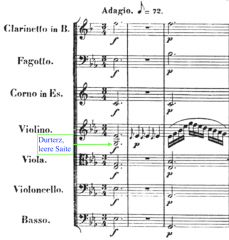
In order to achieve good results in ensemble playing, musicians must communicate and agree on horizontal or vertical intonation Seunghee Lee.
At the beginning of the introduction, an E-flat major chord sounds, without a fifth. At this point the aim should be a pure vertical/harmonic intonation; there is no reason to play one of the chord notes as a melody note. In the violin part, the third sounds on the open G-string. Open strings do not allow any intonation corrections (downwards), so the third becomes the reference tone for the whole ensemble. If one assumes a tempered tuning of the open strings, the E-flat would have to be intoned 13.8 cents higher to obtain a pure third. If one succeeds in playing the ratio 4:5 between the fundamental and the third, the fifth and other overtones of the E-flat Major chord sound as combination notes (see also Geller 2003[1])
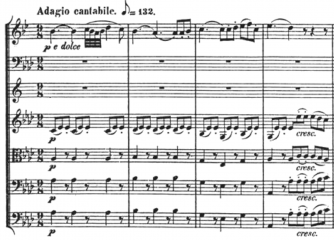
In the third count in the first bar the clarinet plays a sounding c2. In this position, the clarinet's air column vibrates almost its entire length, and intonation corrections are only possible to a limited extent. Only when the strings adjust the intonation, intoning the fundamental A-flat higher, can the chord as a whole sound good and relaxed. If the third is set to the reference tone again, the result is a vertically oriented pure intonation in A flat major.
If the third is taken further, the A-flat major end of bar 1 gains a certain tension, which strives for resolution and gives the phrase more forward direction. In this context, the intonation is described as melodic or horizontally oriented.
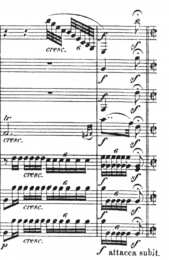
The discussion here focuses on minor sevenths: are the two interval tones major-third and fifth of a triad, or fifth and minor seventh of a dominant seventh chord? A minor seventh would be 1/6 tone lower than the tempered minor seventh; the minor third would be about 13.8 cents higher than a tempered minor third. Intoning the minor seventh very low according to the overtone series results in a combination tone where the fifth matches the bass note, creating an orchestral ensemble sound because it is enriched with additional combination tones.
If the sounding A-flat2 in the clarinet is read as a minor third to the F, then a D-flat is produced as a combination tone, causing a strong dissonance with the fundamental C in the bass. This is also a reasonable interpretation, since the dominant seventh chord then strives all the more for resolution.
Contributions by Interviewees
Harri Mäki distinguishes according to the epoch: Debussy or Ravel often need an equal intonation, Beethoven often requires a harmonic, vertically oriented intonation. In orchestral passages, he recommends playing the thirds somewhat lower (not exactly 13.8 cents) and the fifths as purely as possible (+2 cents – i.e. somewhat higher).
It is easier if you play with piano accompaniment. The intonation must be tuned to the piano, i.e. evenly tempered. Harri Mäki points this out in the chapter "Orientation in the harmonic context." François Benda recommends paying particular attention to this when auditioning with a piano accompaniment. James Campbell mentions a special challenge in the third movement of Schumann’s Fantasiestücke op. 73, where many major thirds must be played in unison with the piano.
Using a Tuner
To learn to play in equal intonation, Alain Billard works with the visual cue of the tuner. He finds it makes sense to first listen to a tone and play it, and only then to check the result visually with the tuner. For ear training, Billard also uses this method to play quarter-tone scales.
Technical Know-How
François Benda cites well-established air flow, air pressure, and breath support as the first prerequisite for achieving a flexible intonation. It is also worth becoming familiar with the differences between the German and French systems. The wider the bore of the upper part of the instrument – this varies between 15.2 mm on the Viennese clarinet and 14.65 mm on French clarinets – the more one has to work with [formants], to avoid being too high in the upper clarinet register.
Correcting with Voicing and Tongue Position
James Campbell uses a slightly higher tongue position to correct the intonation upwards and a slightly lower tongue position for a downward correction, whereby the floor of the mouth is lowered slightly while the jaw remains in the same position. If the jaw position is opened to play a little lower, the tip of the tongue should be aligned in a higher position to maintain the air speed prevent the sound from losing focus.
Milan Rericha and [[Jérôme Verhaeghe#Intonation|Jérôme Verhaeghe] describe the changes in the position of the reed based on voicing: darker voicings correct the intonation downwards, lighter voicings upwards.
Eli Eban points out that different positions of the tongue must be remembered by the ear. Accurately perceiving one’s own tongue position is more difficult than recalling different positions of the arms or hands, where several of the joints have receptors for proprioception. This is not the case with the tongue.
Heinrich Mätzener recommends playing single notes with double-lip embouchure to become aware of the different positions of the tongue and throat opening, combined with a lowering of the floor of the mouth. The movement resembles a concealed yawn, in which the oral cavity is enlarged without opening the jaw. These constellations – tip of the tongue high, throat open, floor of the mouth deep – can also be transferred to the normal embouchure, which should also remain completely stable. In this way one does not experience any loss of tone color (see increased air speed in the area of the tip of ).
David Shifrin follows this sequence: first he tries to find the intonation with the correct "voicing." If necessary, he also uses special fingerings, which can vary depending on the instrument. An important criterion when buying an instrument is the intonation of the twelfths, especially in the upper clarinet register.
Correcting with a Flexible Embouchure Line
In a video with Ira Jay Weinstein, Joe Allard demonstrates the technique of the flexible embouchure line: for slightly higher intonation, or to prevent the pitch from dropping during a crescendo, the mouthpiece may be taken a little further into the mouth. This is controlled by the right thumb, which leads the instrument towards the embouchure. The jaw position remains basically stable. Playing with an embouchure line right at the tip lowers the intonation, which can be useful in extremely quiet places. James Campbell, Richard Stoltzman, John Moses and Heinrich Mätzener also use this technique. As a further possibility, and in combination with a flexible embouchure line, Heinrich Mätzener and Harri Mäki also recommend working with the blowing angle. For an upward correction of intonation, especially towards the climax of a phrase, the clarinet can also be brought closer to the body with a somewhat lower embouchure line.
Correcting by Changing the Larynx Position
Sylvie Hue and Pascal Moraguès look at laryngeal movement, both in connection with the execution of high notes and jumps between different registers, and in the delicate work of intonation corrections. If you place your hand on the larynx and sing different pitches, you immediately notice the different positions. A change of pitch without moving the larynx is hardly possible.
Frédéric Rapin attaches great importance to the "availability" of the larynx and glottis, and to voicing – for the purpose of correcting intonation – as well as to the fact that the embouchure and airflow remain as a stable unit.
Correcting by Changing the Embouchure Pressure & Adjusting Airflow
Gerald Kraxberger makes sure to create the necessary embouchure pressure with the lip muscles ([[Embouchure#Muscle activations and its Functions|Musculus orbicularis oris) and not with the jaw muscles (Musculus masseter). This is best practiced using only the barrel and mouthpiece, since the differences in pitch are very clearly perceptible here. If a downward correction of intonation is necessary, Seunghee Lee and Thomas Piercy lighten the pressure on the reed. At the same time as the embouchure is loosened, the airflow and support must be adjusted and strengthened.
Milan Rericha always forms an oval with his lips, whether the pressure on the embouchure increases or decreases. When the embouchure is loosened, "the sound must be prevented from falling back into the throat and losing its shape."
Ernst Schlader: As a matter of principle, the air should always flow quickly to the mouthpiece. There, the embouchure can be made wider (the intonation becomes somewhat lower) or narrower (somewhat higher). The technique for avoiding any loss of sound quality is hard to verbalize. What remains is implicit learning, supported by a lot of interaction, demonstration by the teacher, and work with the tuner, where the musician plays triads in pure thirds or sixths, using tuner sound as a reference tone.
Correcting by Activating the Mouth Floor Muscles

In addition to the fine corrections to intonation through "inner singing" with its attendant – and automatic – change in the position of the larynx, Heinrich Mätzener recommends exercising the mouth floor muscles. Activating the mouth floor muscles while maintaining a stable embouchure and a relatively static position for both jaw and tongue – the tip of the tongue remaining close to the tip of the reed – produces a glissando which can change the pitch down by a semitone. Importantly, the tone color should not change, and no pressure should be applied to the larynx. On the contrary, the throat opens. This is not the same technique as in jazz glissando, where the starting position is also relaxed. The feeling of pulling down the bottom of the mouth is well-known in everyday life through the covert yawn; clarinetists have only to exhale instead of inhaling.
Attempt at Interpretation

A note from Heinrich Mätzener: "many of the interviewees mention that faster airflow is accompanied by higher intonation and slower speed by lower intonation." The physicists Daniel Bernoulli and Giovanni Battista Venturi were able to demonstrate that a fluid airflow through a pipe of changing diameter increases in speed at the narrowest point, while simultaneously decreasing in pressure (see tec-science website]).
<br<
In the case of the clarinet, this applies to the air, whose path between larynx and mouthpiece can be changed by the above-mentioned factors: larynx (glottis), throat, tongue shape and position, floor of the mouth, and embouchure pressure.
"If the lip position is opened by relaxing the lip muscles, slower air flows through the mouthpiece with the same air supply (at the same air pressure). This results in a slower air flow and the intonation is somewhat deeper. If the lip muscles surround the mouthpiece and the embouchure becomes narrower, faster air flows through the instrument. This results in a higher intonation. The air speed directly in front of the mouthpiece can also be influenced by different voicings, and by higher or lower positions of the tip of the tongue or the base of the mouth, even while maintaining the same embouchure. These factors can be combined in different ways and with differing airflow to achieve the desired result."
Corrections with Special Fingerings
Michel Arrignon primarily uses special fingerings to correct intonation. Additionally, he uses lighter or darker voicings and different reed positions. [Thomas Piercy#Intonation|Thomas Piercy]] uses different fingerings to change the timbre, which he finds allows the intonation to remain unchanged. Ernst Schlader observes that using fingering to correct intonation is more common in the German system, whereas the French system tends to rely on voicing and flexibility of the embouchure.
Different Mouthpieces
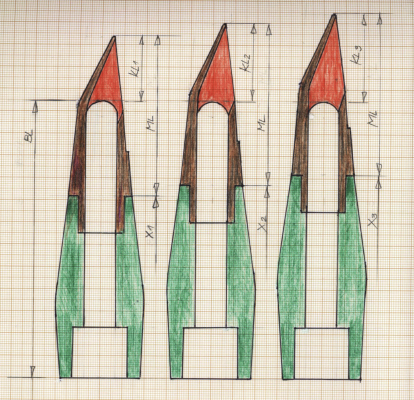
In order to change the basic tuning of the instrument, one can switch to mouthpieces with different dimensions (see also Sunghee Lee)
Andreas Schöni (2005)[2] provides important information on the influence of mouthpiece dimensions:
„Die Veränderung der Mundstückbohrung (Länge oder Durchmesser) wirkt sich nicht in allen Bereichen der Tonskala des Instrumentes in gleichem Masse aus. Wird jedoch das Volumen der Mundstückkammer vergrössert oder verkleinert, verändert sich die Stimmtonhöhe, d.h. alle Töne des Instrumentes werden davon betroffen. [In der Skizze wird sichtbar, dass bei den drei Kombinationen von Mundstück und Birne erstens die Bohrungslänge BL, und zweitens die Mundstücklänge ML, konstant gehalten werden.
Drittens verhalten sich die Volumina der Mundstückkammern wie folgt: KL1 < KL2 < KL3].
Mit dem restaurierten Instrument ist es nun möglich, in den Stimmungen [ca. 432/436/440 Hz] zu spielen, ohne dass die Mittellage unangemessen zu tief wird."“
„Changing the mouthpiece bore (length or diameter) does not affect all areas of the instrument's tone scale to the same extent. However, if the volume of the mouthpiece chamber is increased or decreased, the tuning pitch changes, and therefore all the tones of the instrument are affected. The sketch shows that, with the three combinations of mouthpiece and bulb, the bore length BL and the mouthpiece length ML are kept constant. Thirdly, the volumes of the mouthpiece chambers behave as follows: KL1 < KL2 < KL3. With the restructured instrument it is now possible to play in the different tunings [approx. 432/436/440 Hz] without the middle register becoming too low.“
During a concert, Pascal Moraguès often changes how far in he pushes the barrel or the mouthpiece. Pulling it out changes the length of the bore as well as selectively expanding the inner diameter. Pulling out at the barrel deepens the short notes g1 bis b1, simultaneously sharpening the twelfths (e1/h2, f1/c2). Pulling out at the mouthpiece also deepens the short notes and the notes from c-sharp3 upwards become somewhat deeper.
Frédéric Rapin first looks for the best possible, most well-centered sound based on embouchure shaping and airflow. The intonation can be corrected downwards by pulling out the barrel and middle section. The clarinetist must also always be open to using embouchure pressure, voicing, and support to make adjustments.
Reed Thickness
John Moses rät advises that if the intonation in the upper clarinet register is too low, the reed should be attached higher on the mouthpiece. If the reed is pressed lightly against the mouthpiece, there should be no black line visible between the reed and the mouthpiece. This is especially recommended for somewhat lighter plastic reeds, since these tend to be too low in the upper register.
Heinrich Mätzener generally recommends playing with lighter reeds. While the balance between embouchure and air pressure becomes more difficult, it offers more flexibility for correcting intonation.
Practical Exercises
The Tuner Plays a Reference Tone
The tuner gives an acoustic signal in the form of a reference tone, and the musician practices by playing the selected passage in relation to that tone. This practice technique is suitable for learning to play the intervals in pure intonation. This practice is recommended by James Campbell, Heinrich Mätzener, Ernesto Molinari. The last of whom replaces tone exercises with these intonation exercises. An interval may be sounded "impure" for a longer time, in order to be able to perceive the difference between too high, too low, or pure intonation.
Heinrich Mätzener:
C major triad up to the upper fifth, G7, and then back down to the keynote. The tuner plays the fifth as reference tone. Play the keys chromatically upwards.
James Campbell:
Kroepsch Etude with the tuner playing a reference tone; stop on fifths and octaves.
Harri Mäki:
The beginning of "My Favorite Thing," played while the tuner play the lower fifth as the reference tone. Mäki practices moving chromatically upwards, ensuring that there are no beats; the combination notes must fit the key exactly. Further intonation exercises can be found in Reiner Wehle (2007 and 2008)[3].
Intonation as Part of the Interpretation
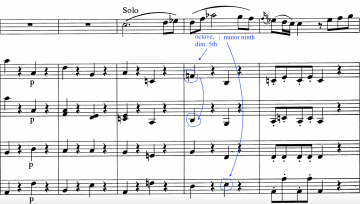
Example: Mozart Clarinet Concerto, m. 76 ff. How should the a-flat2 (sounding 2) be intoned, tempered? On the high side or on the low side? Michel Arrignon considers the a-flat2 to be correct if it is played somewhat lower than tempered. First the a-flat2 sounds like a tritone. Then it changes its function and becomes a minor ninth above the bass tone concert e. If one orients oneself to the proportions of the overtone series, the two notes of the minor ninth (sounding e and f2 in C major, as a parallel key to the current key of a minor) would be intoned rather far. But is it necessary, or even possible, to correct the subjective perception that finds this dissonance between overtone and melody tone? The perception of "correct intonation" is one of the most important basics of interpretation: intonation thus becomes an important means of interpretation.
Intonation as a Priority?
Paolo Beltramini places great importance on clean intonation – as much as on the aesthetics of the sound itself. With the E-flat clarinet in particular, Steve Hartman gives priority to clean intonation as well as the ability to play quietly, which he finds more important than just being able to play fast and loud. In addition to a clean intonation and a beautiful sound, sound and phrasing must be vibrant if the performance is to win over the listener (Steve Hartman, The idea of shape, of saying, of phrasing).
Thomas Piercy does not always share the opinion of his teacher Leon Russianoff that clean intonation must be given priority, even at the expense of timbre (see also Clark 1983[4]).
Historical Sources
Johann Georg Heinrich Backofen
J. G. H. Backofen attaches great importance to pure intonation when playing the clarinet. Since a clarinet with pure intonation cannot be demanded of instrument makers, the skilled player must try the following:
„„... ob nichts durch Nachlassen oder Treiben des Mundes zu gewinnen sei ... Noch wäre zu versuchen, ob nicht mancher falsche Ton durch eine andere Applikatur rein gemacht werden könnte.
... Dieser Lehrer ... der nicht nur das Spiel auf der Klarinette vollkommen versteht, sondern auch die Violine so spielt, dass er darauf den Unterricht erteilen kann, ohne dadurch in der reinen Intonation gestört zu werden ... mache den Schüler gleich anfangs auf jeden falschen Ton aufmerksam und suche ihm bestmöglichst abzuhelfen. Durch diese freylich mühsame, aber auch äusserst nützliche Uebung der reinen Intonation erlangt der Blasinstrumentist den Vortheil eines an Beugsamkeit gewöhnten Ansatzes."“
„... whether there is nothing to be gained by slackening of the mouth ... It would still be necessary to try to find out whether some false notes could be made pure by another application.
... This teacher ... who not only fully understands how to play the clarinet, but who also plays the violin in such a way that he can give lessons without changing the pure intonation ... makes students aware of every wrong note immediately and tries to help them as much as possible. Through this laborious, but also extremely useful exercise in pure intonation, the wind instrument player gains the advantage of an embouchure that is used to flexibility."“
In contrast to Carl Baermann, Johann Georg Heinrich Backofen worked with intonation corrections by modifying ("an embouchure that is used to flexibility") the embouchure and blowing style.
Carl Baermann
For years, Carl Baermann concerned himself with the problems of intonation and with the difficulties of the fingering system. He worked intensively with the instrument maker Benedikt Pentenrieder, a collaboration which he continued with Georg Ottensteiner. In 1860 they presented an instrument in Munich, which showed great improvements in fingering and intonation (see Ottensteiner Clarinet). In contrast to developments in Paris, where [1] and Auguste Buffet introduced the Boehm clarinet in 1839, the bore of the Baermann-Ottensteiner instrument remained largely cylindrical along its entire length. Ottensteiner also continued to use boxwood. Thus, the tonal character of the instruments of the classical epoch remained almost unchanged (see also Stephen Fox, Mühlfeld's Clarinet). Carl Baermann wrote in 1861 in his clarinet method[6]:
„Da die Clarinette, nicht wie alle übrigen Instrumente in die Oktave, sondern in die Duodecim springt, so ist es viel schwieriger, ein rein gestimmtes Instrument zu erhalten, denn die Clarinette hat genaugenommen, für jeden Ton einen besonderen Griff, und aus ein und demselben Tonloch kommen 3-4 gänzlich verschiedene Töne.
Die Aufgabe, die ich mir nun stellte, war folgende: dem Charakter des Instrumentes von keiner Seite nahe zu treten, seine Schwächen der unvollkommenen Reinheit der Scala durch besser Stellung der Tonlöcher zu beheben, und den Mechanismus (darunter verstehe ich das Griffsystem) zu erleichtern und zu vereinfachen."“
„Since the clarinet, unlike all other instruments, does not jump to the octave but rather to the twelfth, it is much more difficult to obtain a purely tuned instrument, because the clarinet has, strictly speaking, a special fingering for each note, and from one and the same tone hole come 3-4 completely different notes.
The task I set myself was as follows: not to approach the character of the instrument from any one angle, to eliminate its weaknesses of the imperfect purity of the scale by better positioning the tone holes, and to make the mechanism (by which I mean the fingering system) easier and simpler.”“
In addition to a detailed fingering chart with many alternative fingerings, Baermann mentions pulling out the bulb as a means of correcting intonation. If the bore in the upper middle section is changed, the range of the twelfth can become too narrow. This can be remedied by carefully reaming the inner bore. Baermann does not discuss adjustments to embouchure and airflow as means of correcting intonation.
Frédéric Berr
Berr addresses intonation in the context of orchestral practice. He recommends playing flexibly – particularly when playing with bassoon and flute – and being willing to accommodate other instrumentalists in case of intonation problems. For the note g1 he demonstrates four different fingering possibilities for correcting intonation.
„Il y a quatre manières de prendre le Sol cela dépend du doigté et de la justesse" (Berr, Klosé: 1837/1907, p.12)".
Übersetzung = There are four ways of fingering the note g', according to the fingering [of the whole passage] and the intonation.“
Further Links, Essays, and Literature
*Reine Stimmung [2] *Doris Geller (1997) gives a theoretical introduction to different intonation systems, explains the phenomena of beats, of difference and combination tones, describes melodic-horizontal and vertically oriented intonation, and provides a practical collection of exercises.
References
- ↑ 1,0 1,1 1,2 Praktische Intonationslehre für Instrumentalisten und Sänger. 2012. Kassel: Bärenreiter
- ↑ 2,0 2,1 Schöni, Andreas 2005. Zum Einfluss des Mundstücks auf Tonhöhe und Stimmung der Klarinette. Referat gehalten anlässlich des Symposiums im Rahmen der 30. Tage Alter Musik in Herne 2005
- ↑ Wehle, Reiner (2007 und 2008). Clarinet Fundamentals. 1. Sound and articulation, 2. Systematic fingering course, 3. Intonation.
- ↑ Clark, Stephen L. 1985. Leon Russianoff: clarinet pedagogue.
- ↑ Johann Georg Heinrich Backofen, Karl Ventzke (Herausgeber): Anweisung zur Klarinette nebst einer kurzen Abhandlung über das Bassetthorn, S. 2. Reprint der Ausgabe Leipzig, 1803. Moeck, Zelle 1986.
- ↑ 6,0 6,1 Carl Baermann: Vollständige Clarinett-Schule: von dem ersten Anfang bis zur höchsten Ausbildung des Virtuosen; Erster Theil Op.63. Johann André, Offenbach/Main 1861. Bayerische Staatsbibliothekdigital
- ↑ Frédéric Berr: Méthode complète de Clarinette adoptée au Conservatoire de Musique de Paris. Paris 1836. [2]
